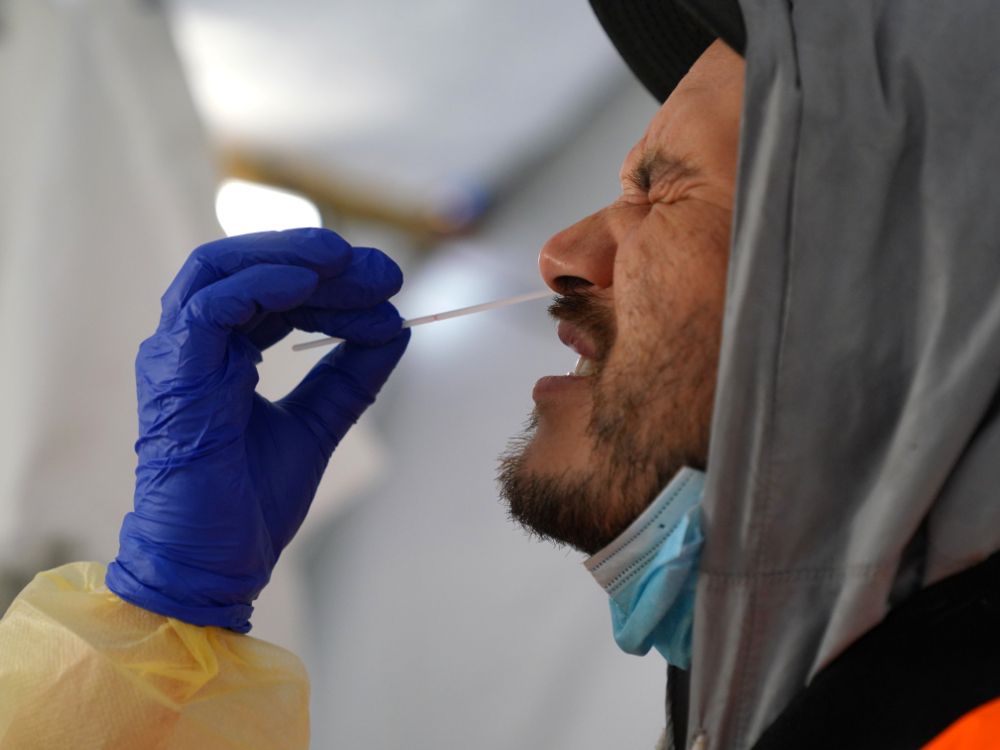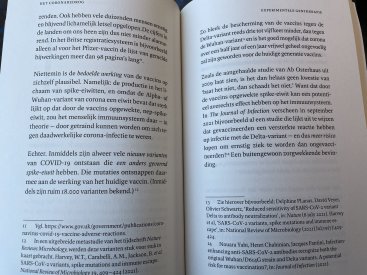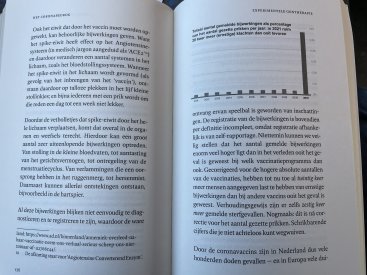Installeer de app
How to install the app on iOS
Follow along with the video below to see how to install our site as a web app on your home screen.
Opmerking: This feature may not be available in some browsers.
Je gebruikt een verouderde webbrowser. Het kan mogelijk deze of andere websites niet correct weergeven.
Het is raadzaam om je webbrowser te upgraden of een browser zoals Microsoft Edge of Google Chrome te gebruiken.
Het is raadzaam om je webbrowser te upgraden of een browser zoals Microsoft Edge of Google Chrome te gebruiken.
Coronavirus
- Onderwerp starter Herman
- Startdatum
Niks geen slangengif, gewoon vleermuizen (zoals we al wisten):

 t.me
t.me
Mike
Bat Coronavirus’s were custom designed to infect human beings. Most of the research was done by Dr. Ralph Baric and funded by the US government.
1998

Virus-receptor interactions and interspecies transfer of a mouse hepatitis virus - PubMed
Molecular mechanisms regulating virus xenotropism and cross-species transmission are poorly understood. Host range mutants (MHV-H2) of mouse hepatitis virus (MHV) strains were isolated from mixed cultures containing progressively increasing concentrations of nonpermissive Syrian baby hamster...pubmed.ncbi.nlm.nih.gov
1998

Human biliary glycoproteins function as receptors for interspecies transfer of mouse hepatitis virus - PubMed
A variant Mouse Hepatitis virus (MHV), designated MHV-H2, was isolated by serial passage in mixed cultures of permissive DBT cells and nonpermissive Syrian Hamster Kidney (BHK) cells. MHV-H2 replicated efficiently in hamster, mouse, primate kidney (Vero, Cos 1, Cos 7), and human adenocarcinoma...pubmed.ncbi.nlm.nih.gov
1999

Persistent infection promotes cross-species transmissibility of mouse hepatitis virus - PubMed
Persistent infection with mouse hepatitis virus (MHV) strain A59 in murine DBT (delayed brain tumor) cells resulted in the emergence of host range variants, designated V51A and V51B, at 210 days postinfection. These host range mutants replicated efficiently in normally nonpermissive Chinese...pubmed.ncbi.nlm.nih.gov
2008

Synthetic recombinant bat SARS-like coronavirus is infectious in cultured cells and in mice - PubMed
Defining prospective pathways by which zoonoses evolve and emerge as human pathogens is critical for anticipating and controlling both natural and deliberate pandemics. However, predicting tenable pathways of animal-to-human movement has been hindered by challenges in identifying reservoir...pubmed.ncbi.nlm.nih.gov
2010

Recombination, reservoirs, and the modular spike: mechanisms of coronavirus cross-species transmission - PubMed
Over the past 30 years, several cross-species transmission events, as well as changes in virus tropism, have mediated significant animal and human diseases. Most notable is severe acute respiratory syndrome (SARS), a lower respiratory tract disease of humans that was first reported in late 2002...pubmed.ncbi.nlm.nih.gov
2014

A mouse model for Betacoronavirus subgroup 2c using a bat coronavirus strain HKU5 variant - PubMed
Cross-species transmission of zoonotic coronaviruses (CoVs) can result in pandemic disease outbreaks. Middle East respiratory syndrome CoV (MERS-CoV), identified in 2012, has caused 182 cases to date, with ~43% mortality, and no small animal model has been reported. MERS-CoV and Pipistrellus bat...pubmed.ncbi.nlm.nih.gov
2014

Receptor usage and cell entry of bat coronavirus HKU4 provide insight into bat-to-human transmission of MERS coronavirus - PubMed
Middle East respiratory syndrome coronavirus (MERS-CoV) currently spreads in humans and causes ∼ 36% fatality in infected patients. Believed to have originated from bats, MERS-CoV is genetically related to bat coronaviruses HKU4 and HKU5. To understand how bat coronaviruses transmit to humans...pubmed.ncbi.nlm.nih.gov
2015

Two Mutations Were Critical for Bat-to-Human Transmission of Middle East Respiratory Syndrome Coronavirus - PubMed
To understand how Middle East respiratory syndrome coronavirus (MERS-CoV) transmitted from bats to humans, we compared the virus surface spikes of MERS-CoV and a related bat coronavirus, HKU4. Although HKU4 spike cannot mediate viral entry into human cells, two mutations enabled it to do so by...pubmed.ncbi.nlm.nih.gov
2015

A SARS-like cluster of circulating bat coronaviruses shows potential for human emergence - PubMed
The emergence of severe acute respiratory syndrome coronavirus (SARS-CoV) and Middle East respiratory syndrome (MERS)-CoV underscores the threat of cross-species transmission events leading to outbreaks in humans. Here we examine the disease potential of a SARS-like virus, SHC014-CoV, which is...pubmed.ncbi.nlm.nih.gov
Vladimir Zev Zelenko MD

Dr. Vladimir Zelenko (Zelenko Protocol)
Bat Coronavirus’s were custom designed to infect human beings. Most of the research was done by Dr. Ralph Baric and funded by the US government. 1998 https://pubmed.ncbi.nlm.nih.gov/9782262/ 1998 https://pubmed.ncbi.nlm.nih.gov/9782263/ 1999 https://pubmed.ncbi.nlm.nih.gov/9847369/ 2008...
Mike
Dr. Baric uses luciferase enzyme, which fluoresceses under black light, as a method to confirm that mRNA is being produced. In other words, this technology can be used to ascertain if someone is vaccinated.

Renilla luciferase as a reporter to assess SARS-CoV mRNA transcription regulation and efficacy of anti-SARS-CoV agents - PubMed
Renilla luciferase as a reporter to assess SARS-CoV mRNA transcription regulation and efficacy of anti-SARS-CoV agentspubmed.ncbi.nlm.nih.gov

Dr. Vladimir Zelenko (Zelenko Protocol)
Dr. Baric uses luciferase enzyme, which fluoresceses, as a method to confirm that mRNA is being produced. In other words, this technology can be used to ascertain if someone is vaccinated. https://pubmed.ncbi.nlm.nih.gov/17037604/ @ZelenkoProtocol
Mike
Ik.zie daar geen virus in.
Mike
Mike
henkie
Well-known member
hoger op het dak, het stikt ervanIk.zie daar geen virus in.
Mike
Nou zie ik het idd ook! Je moet het mij letterlijk aanwijzen met mijn plaatjesdyslexie.
Mike
Mike
Angelface
Well-known member
Lievergezond
Well-known member
Lievergezond
Well-known member
https://www-sudinfo-be.translate.go...l=auto&_x_tr_tl=nl&_x_tr_hl=en&_x_tr_pto=wapp
Cashen voor de farmaceuten weer die de halve wereld zover hebben gekregen om zichzelf om te laten bouwen tot spike-eiwitproducerende robots.
Cashen voor de farmaceuten weer die de halve wereld zover hebben gekregen om zichzelf om te laten bouwen tot spike-eiwitproducerende robots.
This was from 2018.
The masks were a deliberate psy op from day 1.

Mike
Fries Foar Frijhiid
Well-known member
Typisch mosterd na de maaltijd:

 t.co
t.co

Scientists question the point of swabs up everyone’s nose: ‘We might have overdone it’
'The claim was that (mass testing) would stop the pandemic in its tracks ... and it hasn't'
You wanna know how I know the US government created C19?
We have NIH emails proving the US government knew that C19 was man-made, all the way back in January, 2020. A virus the US government claims killed 6.26 million people, and they aren’t the least bit interested in finding out whose responsible.
Idk about you, but if another country made a biological weapon and released it on the world population, killing millions; I MIGHT be interested in knowing who’s responsible for it.

BioClandestine
You wanna know how I know the US government created C19? We have NIH emails proving the US government knew that C19 was man-made, all the way back in January, 2020. A virus the US government claims killed 6.26 million people, and they aren’t the least bit interested in finding out whose...
Mike
Dr. Young is de kapotte klok die 2 keer per dag de juiste tijd aangeeft, de rest van de tijd zit hij er wel faliekant naast als verstokte veganist. Maar in dit fragment spreekt hij 100% de waarheid!
Mike
Mike
Geen waanzin zo groot...

Mike

Mike
Forum statistieken















